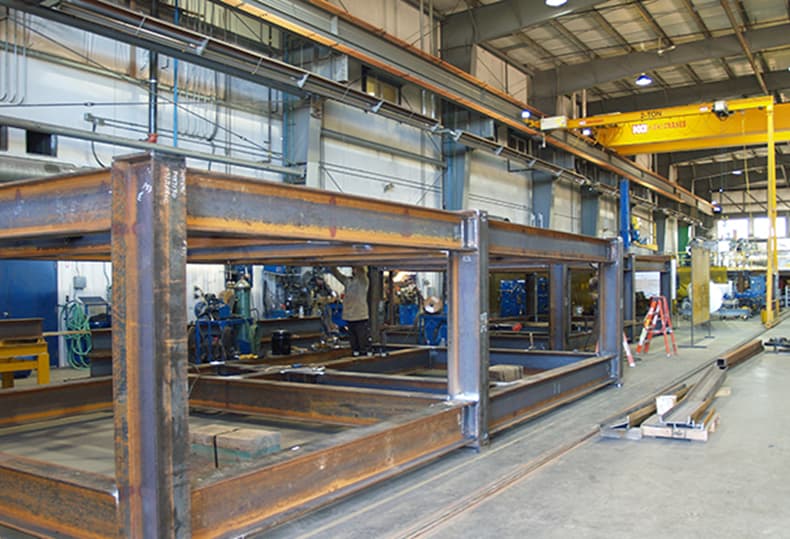Steel Fabrication Melbourne: Craftsmanship Satisfies Advancement
Steel Fabrication Melbourne: Craftsmanship Satisfies Advancement
Blog Article
Cutting-edge Trends in Steel Fabrication: Enhancing Toughness and Precision
In the realm of steel manufacture, the search of longevity and accuracy has brought about a wave of ingenious fads that are reshaping the sector. From innovations in welding innovations to the integration of robot automation in construction processes, the landscape of steel manufacturing is progressing rapidly. High-strength alloy growth, coupled with the usage of 3D modeling and simulation software application, is pressing the boundaries of what is possible in terms of structural stability and accuracy. The growing focus on sustainable methods in steel manufacturing is not only driving effectiveness yet also cultivating a more ecologically aware approach to construction. These patterns are not simply shaping the existing but likewise laying the groundwork for the future of steel manufacture, promising further improvements in resilience and precision.
Advanced Welding Technologies
In the realm of steel construction, the fostering of advanced welding modern technologies has significantly reinvented the industry's approach to attaining remarkable quality and accuracy in architectural welds. Advanced welding technologies, such as laser light beam welding and friction mix welding, have emerged as game-changers in the area. By leveraging these sophisticated welding techniques, steel producers can boost the toughness, toughness, and precision of their architectural welds, meeting the progressively requiring requirements of modern construction jobs.
Robot Automation in Fabrication
Accepting robotic automation has become a foundation of modern-day steel fabrication methods, improving procedures and enhancing performance across the market. Robotics are changing the way steel components are manufactured, using unrivaled accuracy and rate while lowering human mistake. These automated systems can handle repeated jobs with regular precision, bring about higher top quality final result.
One secret advantage of robotic automation in steel construction is the capability to function all the time without exhaustion, considerably boosting manufacturing outcome. This continual operation lessens downtime and increases task timelines, inevitably conserving costs for producers. Additionally, robots can be programmed to perform detailed tasks that may be unsafe or tough for human employees, enhancing safety in the workplace.
Furthermore, robot automation enables seamless assimilation with other electronic modern technologies, such as computer-aided design (CAD) software program and Internet of Points (IoT) systems (steel fabricators melbourne). This interconnected strategy enhances communication between different stages of construction, maximizing workflows and making sure real-time tracking and control. As the steel fabrication industry continues to progress, robot automation stands out as a transformative pressure driving efficiency and precision in producing procedures

High-Strength Alloy Advancement
The improvement of high-strength alloy advancement in steel construction is improving the industry's method to improving material toughness and efficiency. High-strength alloys are engineered to display superior mechanical properties, such as increased tensile strength, toughness, and corrosion resistance compared to conventional steel grades. By incorporating these advanced alloys right into manufacture processes, makers can create elements that endure higher stress and anxiety degrees and extreme atmospheres, leading to more long lasting and reliable final product.
One key advantage of high-strength alloy advancement is the capability to decrease product thickness without endangering structural integrity. This not only results in lighter-weight parts however also adds to cost financial savings and enhanced efficiency in manufacture and setting up processes. In addition, the enhanced strength-to-weight ratio of these alloys permits for the style and construction of structures with greater load-bearing capabilities while reducing total weight.
3D Modeling and Simulation Software Application
Innovations in steel manufacture processes have been dramatically propelled by the integration of innovative 3D modeling and simulation software program devices. These devices permit makers to develop detailed online models of their jobs, enabling them to visualize the final item with precision before any type of physical work begins.

Lasting Practices in Steel Production
Including sustainable techniques into steel manufacturing processes is important for minimizing ecological impact and making sure long-term resource availability. One vital sustainable technique is the adoption of energy-efficient innovations to reduce greenhouse gas discharges throughout the steel manufacturing procedure. This consists of using renewable resource sources, such as solar or wind power, to power steel plants and carrying out energy-efficient tools to optimize power use.
Another vital aspect of lasting steel manufacturing is the responsible sourcing of basic materials. This includes making certain that the iron ore and other resources used in steelmaking are gotten from honest and ecologically pleasant sources. By promoting transparency in the supply chain and sticking to rigorous ecological standards, steel producers can lessen the negative effects of source removal on neighborhood environments and areas.

Final Thought
In final thought, the ingenious trends in steel manufacture such as innovative welding innovations, robotic automation, high-strength alloy advancement, 3D modeling and simulation software application, and sustainable techniques are improving the sturdiness and precision of steel items. These innovations are changing the steel construction industry by boosting effectiveness, quality, and sustainability. It is clear that the future of steel construction hinges on welcoming these sophisticated technologies to satisfy the demands of contemporary construction and production industries.
In the redirected here realm of steel manufacture, the search of toughness and precision has actually led to a wave of ingenious trends that are improving the sector.In the world of steel construction, the adoption of cutting-edge welding modern technologies has dramatically changed the industry's technique to attaining exceptional high quality and accuracy in structural welds. As the steel construction market proceeds to develop, robotic automation stands out as a transformative pressure driving effectiveness and precision in producing procedures.
Additionally, recycling and recycling steel scrap and waste products play a considerable duty in enhancing the sustainability of steel production. steel fixing.In conclusion, the innovative patterns in steel manufacture such as innovative welding technologies, robotic automation, high-strength alloy development, 3D modeling and simulation software application, and lasting techniques are enhancing the resilience and precision of steel products
Report this page